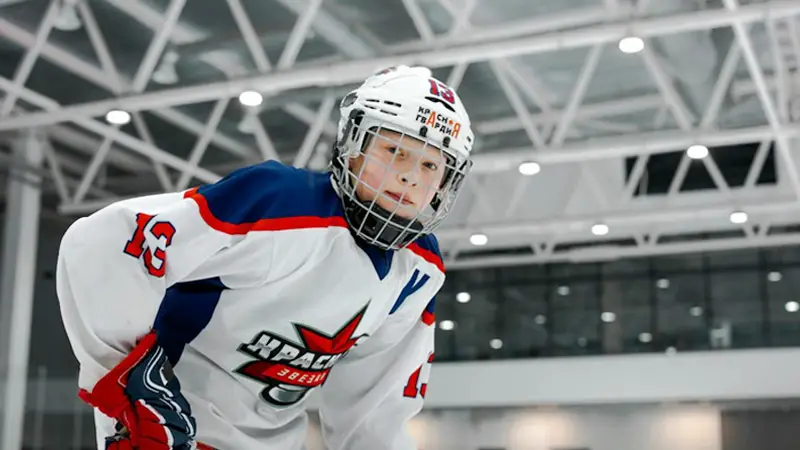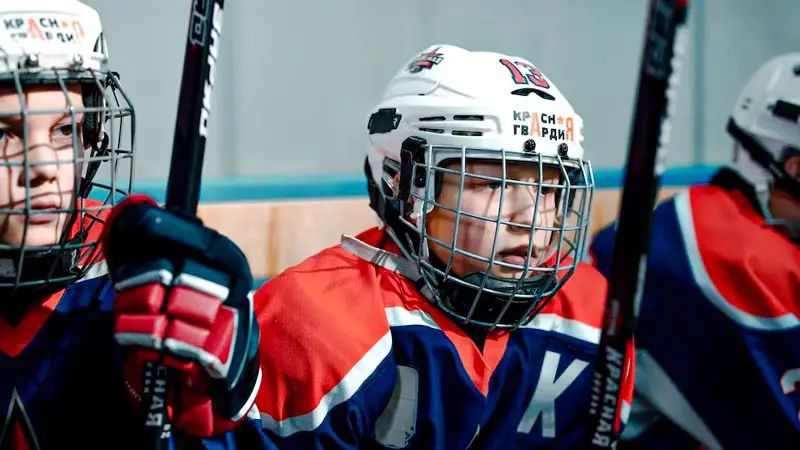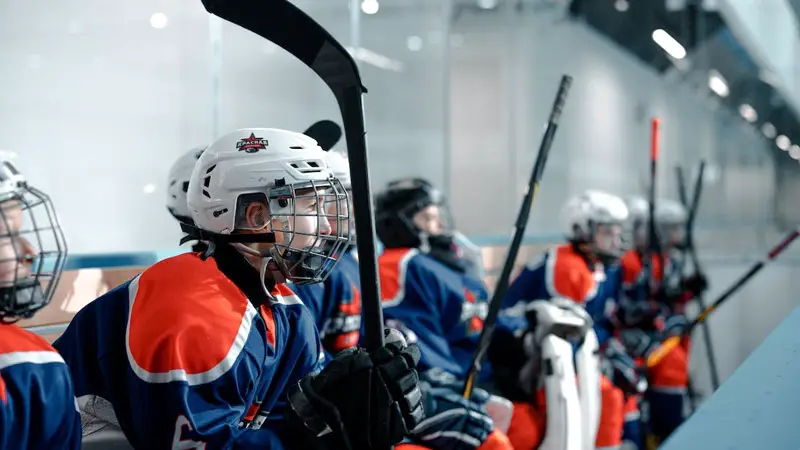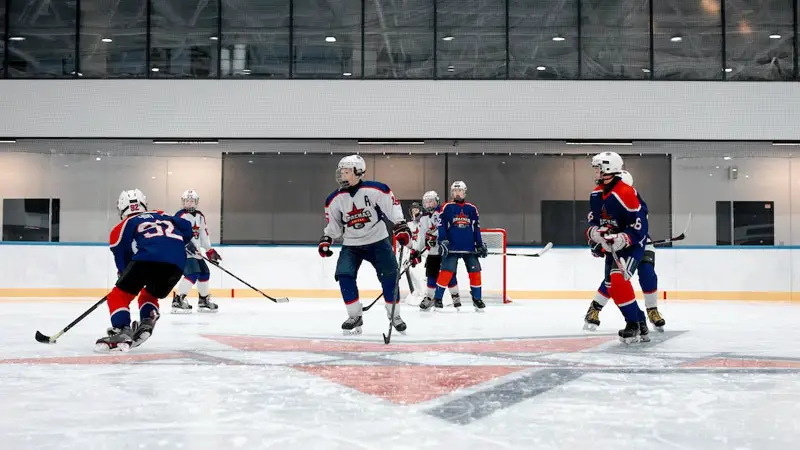Women’s hockey, like its male counterpart, is a dynamic and intense sport where players glide across the ice with remarkable speed, precision, and tenacity.
In the midst of this thrilling action, one crucial aspect sets the foundation for a secure and competitive game: facial protection. Women’s hockey players often don full cages or visors, a choice that isn’t just about preference but prioritizing safety above all else.
This blog post delves into the reasons why women’s hockey players opt for facial protection, exploring how it safeguards against potential injuries and contributes to the overall well-being of athletes.
From understanding the regulations surrounding this equipment to the impact it has on performance, we’ll provide insights into the critical role cages play in women’s hockey.
Do All Hockey Players Wear Cages?
No, not all hockey players wear cages. The use of facial protection in hockey varies depending on the level of play and the player’s preference. Here are some common types of facial protection used in hockey:
Cages
Cages are full-face shields made of metal bars or wire mesh. They provide the highest level of protection and are commonly worn by players in youth leagues, amateur leagues, and many professional leagues.
Visors
Visors are clear, plastic shields that protect the eyes and upper face. They do not provide full-face protection but are mandatory in many professional leagues, including the NHL, for players who did not wear a visor before a certain date.
Some amateur players also choose to wear visors for added protection.
Half Shields
Half shields are similar to visors but cover only half of the face. They protect the eyes but leave the lower face exposed. They are allowed in many leagues but do not offer as much protection as full cages or visors.
No Facial Protection
In some cases, particularly in professional leagues, players may choose not to wear any facial protection. This is relatively rare, as the risk of facial injuries is high in hockey.
The specific rules and regulations regarding facial protection can vary from one league or organization to another, so players should be aware of and follow the guidelines set by their respective governing bodies.
Additionally, personal preference also plays a significant role in a player’s choice of facial protection, with some players opting for less coverage for better visibility or comfort.
However, safety should always be a priority in hockey, and players should choose the level of protection that best suits their needs while minimizing the risk of injury.
Why Do Women’s Hockey Wear Cages?
Women’s hockey players, like their male counterparts, wear cages, visors, or full face shields for several reasons, primarily related to safety and protection. Here are some reasons why women’s hockey players wear cages:
Safety

Safety is a top priority in hockey, and facial protection helps reduce the risk of serious injuries, such as facial fractures, dental injuries, and eye injuries. Cages provide comprehensive protection for the entire face, including the eyes, nose, and mouth.
Similar Rules
In many leagues and organizations, the rules governing facial protection in women’s hockey are similar to those in men’s hockey. These rules often require players to wear full cages, visors, or some form of facial protection to enhance safety and reduce the risk of injury.
Protecting Vision
Hockey involves high-speed play with pucks and sticks, which can pose a significant risk to a player’s eyesight. Wearing a cage or visor helps protect the eyes from being hit by pucks, sticks, or other players’ equipment.
Mandatory in Some Leagues
In some women’s hockey leagues and age groups, full cages or visors may be mandatory, especially at the youth and amateur levels. These rules are implemented to ensure the safety of all players.
Role Modeling
Many professional women’s hockey players set an example by wearing proper facial protection. Younger players often look up to these role models and may be more likely to follow their lead in wearing cages or visors.
It’s important to note that player safety is a paramount concern at all levels of hockey, and the use of facial protection is a key aspect of ensuring that safety.
While some players may have personal preferences for certain types of facial protection, they must adhere to the rules and regulations established by their respective leagues and organizations to promote safety and minimize the risk of injuries.
Importance of Cages for Women Hockey Players
The use of cages or full-face protection is of paramount importance for women’s hockey players for several significant reasons:
Safety
Safety is the most crucial reason for wearing cages in women’s hockey. The game involves high-speed play with a hard puck and potentially dangerous equipment (e.g., sticks), which can result in serious facial injuries if not properly protected.
Cages provide comprehensive protection for the entire face, reducing the risk of facial fractures, dental injuries, and eye injuries.
Eye Protection

One of the most critical aspects of wearing cages is the protection they offer to a player’s eyes. Hockey pucks, sticks, and other players’ equipment can cause severe eye injuries if they make contact with an unprotected face.
Cages serve as a barrier to prevent these injuries, ensuring that players can continue to play the game without risking their vision.
Mandatory in Many Leagues
In many women’s hockey leagues, especially at the youth and amateur levels, the use of cages or visors is mandatory.
These rules are in place to prioritize player safety and minimize the risk of injury. Players who do not adhere to these regulations may face penalties or suspensions.
Role Modeling
Professional women’s hockey players, who often serve as role models for younger players, frequently wear full facial protection.
This sets a positive example for aspiring players and reinforces the importance of safety in the sport. It encourages younger players to adopt responsible practices when it comes to facial protection.
Confidence and Focus
Wearing a cage or full-face shield can boost a player’s confidence and focus on the game.
Players can concentrate on their skills, strategies, and teamwork without worrying about the potential for facial injuries. This can enhance their overall performance and enjoyment of the sport.
Long-Term Health
Facial injuries can have long-lasting physical and psychological effects.
By wearing cages, women’s hockey players are taking steps to protect their long-term health and well-being, ensuring they can continue to enjoy the sport without the risk of debilitating injuries.
The use of cages in women’s hockey is crucial for player safety, injury prevention, and maintaining the overall integrity of the game.
It’s not only about complying with rules and regulations but also about prioritizing the health and well-being of the players, enabling them to enjoy and excel in the sport with confidence and peace of mind.
Why Don’t NHL Players Wear Cages?

NHL players do not wear cages as their primary form of facial protection for several reasons:
Visors Are Mandatory
In the NHL, visors (clear, plastic shields that protect the eyes and upper face) are mandatory for players who enter the league after a certain date.
This rule was introduced to enhance player safety and reduce the risk of eye injuries while allowing players to have better visibility and airflow compared to full cages.
Players who were already in the league before the rule was implemented are “grandfathered” and not required to wear visors, but many still choose to do so voluntarily.
Comfort and Visibility
Cages can restrict a player’s field of vision and make it more challenging to track the puck and opponents.
Visors, by contrast, provide protection while allowing for better peripheral vision. This improved visibility is particularly important in a fast-paced sport like hockey.
Familiarity and Tradition
Many NHL players grew up playing without facial protection, so they are more accustomed to the feeling of wearing visors or even going without any facial protection.
There is a certain level of tradition and “toughness” associated with not wearing a full cage, which can influence players’ decisions.
Impact on Play
Some players believe that wearing a full cage or shield can impact their play, including their ability to communicate effectively with teammates, their peripheral vision, and their overall performance.
They may feel that visors strike a balance between safety and on-ice performance.
Personal Choice

In the NHL, players have the option to wear a full cage or shield if they choose to do so, regardless of whether they are required to wear a visor.
Some players do choose to wear full cages, especially if they have previously experienced facial injuries and want additional protection.
While visors are mandatory for many NHL players, they are preferred over full cages because they provide a balance between safety and performance.
However, the use of visors remains a matter of personal choice for some players who are not required to wear them, and a few may opt for full cages or shields for added protection.
Ultimately, player safety is a priority at all levels of hockey, and the NHL continually evaluates and adjusts its rules and equipment requirements to enhance safety while considering the preferences and experiences of the players.
Differences Between Men’s and Women’s Hockey Gear
While the basic gear and equipment used in men’s and women’s ice hockey are similar, there can be some differences due to variations in body shape, size, and playing styles between male and female players.
Here are some key differences between men’s and women’s hockey gear:
Chest and Shoulder Protection
- Men’s: Men’s shoulder pads are typically designed with broader shoulders and more bulk to accommodate the male physique.
- Women’s: Women’s shoulder pads are often more contoured to fit the female body shape, with adjustments to provide better comfort and mobility.
Pelvic Protection
- Men’s: Men’s pelvic protection (also known as a cup or jock) is designed to protect the male groin area.
- Women’s: Women’s pelvic protection may have a different design to offer protection while accommodating the female anatomy.
Breast Protection
Women’s: Some female players may choose to wear additional chest protection to protect the breasts. This is typically not a concern for male players.
Hockey Pants
Women’s: Women’s hockey pants may have a more tailored fit and shape to accommodate the female body.
Jock/Jill Shorts
Women’s: Some female players wear jill shorts, which are designed to provide pelvic protection while accommodating the female body. These are similar to men’s jock shorts but with specific adjustments for fit.
Goalie Gear
Women’s goalie gear is generally designed to fit the female body shape, with adjustments in chest protectors, leg pads, and other gear to ensure comfort and protection.
Skates
Skates themselves are not gender-specific, but the choice of skate size and fit may vary based on individual foot shape and size.
Some brands offer skates designed specifically for women, taking into account differences in arch height and foot shape.
Sticks
Hockey sticks are not gender-specific, but players choose sticks based on their personal preferences for length, flex, and blade pattern.
Helmet and Facial Protection
The type of helmet and facial protection used is not gender-specific and is based on personal preference and league regulations. Many players, regardless of gender, opt for visors or cages for facial protection.
Jerseys and Socks
Jerseys and socks are typically not gender-specific and are often designed with team branding and colors rather than gender-specific features.
While there are some gender-specific adjustments in hockey gear, individual player preferences and comfort are significant factors.
Players should choose gear that fits well, provides adequate protection, and allows for optimal mobility and performance on the ice. Additionally, league rules and regulations may dictate specific gear requirements, which all players must adhere to for safety reasons.
FAQs
Why do women’s hockey players wear cages?
Women’s hockey players wear cages for safety and injury prevention. Cages protect the entire face, reducing the risk of facial injuries, dental damage, and eye injuries from high-speed pucks, sticks, and collisions on the ice.
Are cages mandatory in women’s hockey?
The requirement for cages varies by league and age group. In many women’s hockey leagues, especially at the youth and amateur levels, full cages or visors are mandatory to prioritize player safety.
Can players choose between cages and visors in women’s hockey?
Yes, players in women’s hockey often have the option to choose between full cages, visors, or other facial protection, depending on personal preference and league rules. However, safety should be a top consideration.
Do cages affect a player’s performance in women’s hockey?
While cages may slightly impact peripheral vision, most players adapt quickly. Safety should always take precedence, and the benefits of facial protection outweigh minor visibility adjustments.
Cages allow players to focus on their skills and the game with peace of mind.
Do professional women’s hockey players wear cages?
In professional women’s hockey leagues, the use of facial protection varies. Some players opt for visors, while others choose to wear full cages based on personal preference.
However, safety remains a priority, and many players prioritize facial protection to prevent injuries.
Wrapping Up
In women’s hockey, the decision to wear cages is not merely a matter of choice; it’s a commitment to player safety.
These protective shields are more than just pieces of equipment; they represent a sport’s dedication to reducing risks and ensuring that players can pursue their passion without fear of devastating facial injuries.
As the game continues to evolve, one thing remains constant: the unwavering importance of cages in women’s hockey, allowing players to embrace the ice with confidence, enthusiasm, and above all, security.
I’m sure that you have got why women’s hockey wear cages. Still, if you have any confusion, you can let us know in the comment section. Thank you for your time.





Benjamin Kenyon